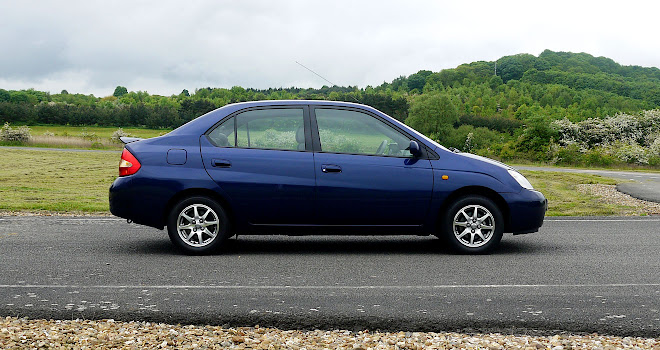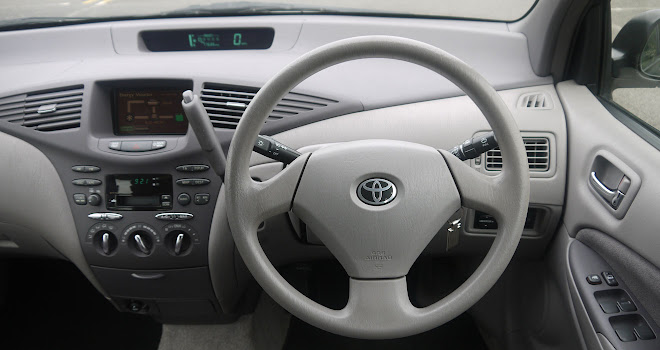Nineteen years is a long time in car manufacturing. Long enough for Toyota to have produced four generations of Prius, the latest of which went on sale in the UK just a couple of months ago.
This car, of course, is the first of the breed. Launched in Japan in December 1997, it was the world’s first mass-produced hybrid car, beating the slinky Honda Insight to the punch by almost two years. And while the original Insight looked like a freshly landed UFO, the first Prius looked, well, like a UFO in which the F stands for “fugly”.

The droopy nose, teeny wheels and truncated rear end obviously worked in the wind tunnel, however, yielding a drag coefficient of 0.29. Not as good as the Insight’s 0.25, but the Prius’s score would still count as a good effort today.
While the tiny two-seater Insight was all about fuel efficiency with practicality a distant secondary concern, the original Prius attempted to balance the two goals. It’s a reasonably spacious five-seater saloon with a proper boot. There is an awkward lump above the rear axle, where the car’s hybrid battery lives, but you can still flop the rear seatbacks forwards and slide long loads through into the cabin. That makes the 1997 Prius considerably more versatile than the Honda Civic Hybrid of a decade later, which housed its battery higher up between the cabin and the boot with no option to fold the rear seats.
About 1,200 first-generation Priuses were sold in the UK between 2000 and 2003, a few more have been imported since and about 1,000 are still around. Condition rather than age will dictate the current value – expect to pay at least £1,500 for a good example and, as with any secondhand car, it’s worth getting an HPI check before handing over any cash.

When it first arrived in the UK, the first Prius had already established itself as a popular choice in its home market – which may or may not have been a good thing for Toyota. Rumours abounded at the time that every Prius cost £11,000 more to build than to buy.
Certainly it was still a somewhat suspect notion at the time to supplement a combustion engine with an expensive nickel-metal hydride battery and electric motor. Even the increases in efficiency were hotly debated, with pundits complaining that it was wasteful to cart around a stack of hefty batteries. These days, of course, the hybrid approach is proven to the extent that you can buy petrol-electric Ferraris and Porsches.

The first-generation Toyota Hybrid System combines a 1.5-litre four cylinder petrol engine producing 70bhp with an electric motor yielding 33kw (44bhp).
The pair are connected to the front wheels via an epicyclic gearset, which allows a computerised control system to selectively adjust the flow of power. By freeing or braking different elements of the gearset, either the engine or electric motor can drive the wheels independently, the pair can join forces to propel the car, or the engine can drive both car and motor at the same time, generating electricity to top up the battery as it goes along.
The gear ratio between engine and wheels can be varied smoothly, yielding the elastic feel of a continuously variable transmission where revs and road-speed bear no relation.

This feature allowed the car’s engineers to optimise the engine to run within a relatively narrow band, which was great for raising fuel economy. No matter how hard you press the accelerator, the Prius’s engine will never spin faster than 4,500rpm. Although, given there’s no rev counter in the thin strip of green LCD instruments, we’ll have to take Toyota’s word for it.
The results were exceptional for the time: 57.6mpg on the combined cycle, 114g/km in CO2 terms, and significant reductions in tailpipe pollutants compared to petrol or diesel alternatives.

Approached today, the first thing that strikes when you climb aboard the Mk 1 Prius is the unrelenting sea of pale grey surfaces that makes up the interior. Look beyond the dated plastic and velour, however, and it’s clear how closely subsequent Prius generations have followed the template set by this one. I was surprised, for example, to find that the deeply shrouded 5.8-inch display in the centre of the dashboard is a touchscreen, with interactive buttons among its blocky, low-res graphics.
This old Prius doesn’t have the spring-loaded transmission toggle of later Toyota hybrids, however. Instead there’s a dash-mounted wand that looks like a misplaced handbrake, with which you can select among P, R, N, D and B much as you might pump out a pint of beer. The actual handbrake is a foot-operated pedal that you press to set and press again to release.
There’s no start button – you turn the key and wait for the “Ready” light to spring up among the minimalist digital instruments, after which you can set off quite smartly on the electric motor alone.
The engine quickly chimes in as speed builds and the revs will surge whenever you ask for even moderate acceleration. The engine will tend to thrash away at its set speed – a white noise rather than a thrum from under the bonnet. The available power feels modest by modern standards. When new, 62mph would arrive in a leisurely 13.4 seconds and no doubt this 77,000-mile example is slower still. Climbing hills can feel a struggle too, with the Prius unable to maintain speed up really steep inclines. The hybrid’s 1,250kg kerb weight doesn’t help.

Going downhill again, you can slot the transmission into B and enjoy the knowledge that you’re recapturing energy other contemporary cars would let go to waste. The central screen can display a graphic illustration of power flows, or a bar chart of petrol consumption and energy regenerated.
The old Prius’s handling is surprisingly tidy for a car that has evidently been optimised for comfort, running on low-resistance rubber to boot. The electrically assisted steering wheel feels pretty lifeless, but you’d have no complaints driving this Prius over a catered city street, and it does a fine job of smothering road-humps.
The regenerative brakes feel pretty numb too but are more linear than those of an early Honda hybrid, while the throttle does tend to feel as if it’s connected to the car via strings of wet spaghetti.
Compared to the new fourth-generation Prius, this early example seems crude, very slow and extremely plasticky. But it’s still an impressively frugal thing for a car of its size, and offers much the same relaxed and appealing charm you’ll still find in the latest Prius of today.





